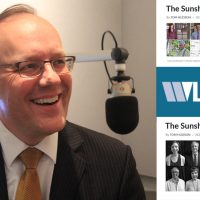Tom Hudson, VP of News at WLRN

In a journalism career covering news from high global finance to neighborhood infrastructure, TOM HUDSON is the Vice President of News and Special Correspondent for WLRN. He hosts and produces the Sunshine Economy and anchors the Florida Roundup in addition to leading the organization’s news engagement strategy.
Hudson was most recently the co-anchor and managing editor of Nightly Business Report on Public Television. In that position Hudson reported on topics such as Federal Reserve interest rate policy, agriculture and global trade. Prior to co-anchoring NBR, he was host and managing editor of the nationally syndicated financial television program “First Business.”
Tom also reported and anchored market coverage for the groundbreaking web-based financial news service, WebFN. Beginning in 2001, WebFN was among the first live online streaming video outlets. While there he reported regularly from the Chicago Board Options Exchange, Chicago Board of Trade and the CME.
Before his jump to television and broadband, Tom co-anchored morning drive for the former all-news, heritage 50kw WMAQ-AM/Chicago. He spent the better part of a decade in general news as anchor, reporter, manager and talk show host in several markets covering a wide variety of stories and topics.
He has served as a member of the adjunct faculty in the Journalism Department of Columbia College Chicago and has been a frequent guest on other TV and radio programs as well as a guest speaker at universities on communications, journalism and business.
Tom writes a weekly column for the Miami Herald and the McClatchy-Tribune News Service. He appears regularly on KNX-AM/Los Angeles and WBBM-AM/Chicago for commentary on the economy and investment markets.
While Tom was co-anchoring and managing NBR, the program was awarded the 2012 Program of Excellence Award by American Public Television. Tom also has been awarded two National Press Foundation fellowships including one for the Wharton Seminars for Business Journalists in 2006. He graduated Phi Beta Kappa from the University of Iowa and is the recipient of several professional honors and awards for his work in journalism.
He is married with two boys who tend to wake up early on the weekends.
— WLRN website
The videos below are organized by topic and run between 30 seconds and 5 minutes. Click on any video. You must be connected to the Internet to view the videos.
INSIGHT & INSPIRATION: 1:47 min.
UNDERSTANDS THE AUDIENCE’S PERSPECTIVE: 0:29 sec.
COLLABORATION: 2:05 min.
EXPOSURE TO BROAD INFLUENCES: 0:44 sec.
SEIZES OPPORTUNITIES: 3:01 min.
INSIGHT & INSPIRATION: 1:32 min.
UNDERSTANDS THE AUDIENCE’S PERSPECTIVE: 2:45 min.
CRITICAL THINKING: 2:08 min.
CRITICAL THINKING: 3:17 min.
UNDERSTANDS THE AUDIENCE’S PERSPECTIVE: 0:44 sec.
COMMUNITY VALUES: 2:05 min.
INSIGHT & INSPIRATION: 2:14 min.
INSIGHT & INSPIRATION: 2:12 min.
UNDERSTANDS THE AUDIENCE’S PERSPECTIVE: 1:42 min.
DEVELOP A VOICE: 1:45 min.
SEIZES OPPORTUNITIES: 3:29 min.
CREATIVE FLEXIBILITY: 3:36 min.
COMMUNITY VALUES: 0:58 sec.
UNDERSTANDS THE BUSINESS OF ART: 3:04 min.
UNDERSTANDS THE AUDIENCE’S PERSPECTIVE: 3:26 min.
CRITICAL THINKING: 3:47 min.
OVERCOMES CHALLENGES TO SUCCEED: 2:37 min.
OVERCOMES CHALLENGES TO SUCCEED: 2:42 min.
INSIGHT & INSPIRATION: 3:41 min.
EMPATHY: 1:07 min.
COMMUNITY VALUES: 1:50 min.

